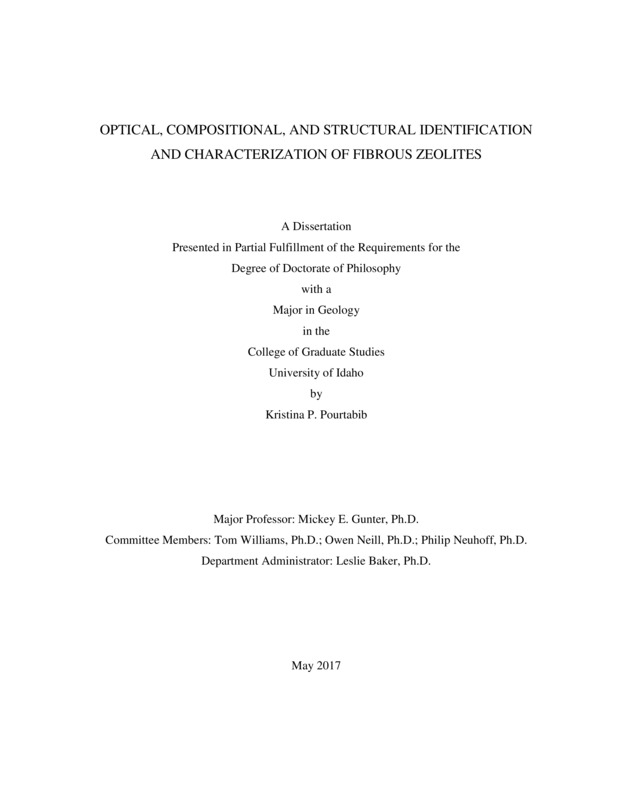Optical, Compositional, and Structural Identification and Characterization of Fibrous Zeolites
Pourtabib, Kristina. (2017). Optical, Compositional, and Structural Identification and Characterization of Fibrous Zeolites. Theses and Dissertations Collection, University of Idaho Library Digital Collections. https://www.lib.uidaho.edu/digital/etd/items/pourtabib_idaho_0089e_11112.html
- Title:
- Optical, Compositional, and Structural Identification and Characterization of Fibrous Zeolites
- Author:
- Pourtabib, Kristina
- Date:
- 2017
- Keywords:
- electron probe microanalysis erionite offretite optical mineralogy selected area electron diffraction zeolites
- Program:
- Geology
- Subject Category:
- Geology
- Abstract:
-
Zeolites are a group of aluminosilicate minerals containing various channel and cage structures that allow for the exchange of cations and H2O. Many of fibrous and/or acicular zeolite samples share similar hand sample characteristics making identification by more detailed means essential. Most of the zeolite minerals can be distinguished based on differences in composition, structure and optics. The two zeolite minerals erionite and offretite contain many overlapping properties that make differentiation problematic at times. Erionite is listed as a Group I carcinogen meaning that it is known to cause cancer in humans and animals alike, although the mechanisms by which erionite induces cancer are still unclear. Conversely, offretite does not possess these carcinogenetic properties. Being able to accurately distinguish erionite from other zeolite species will allow for analytical testing laboratories to develop more accurate means of recognizing erionite in an unknown sample.
The zeolites in this study were analyzed using Electron Probe Microanalysis (EPMA) for composition, Selected Area Electron Diffraction on the Transmission Electron Microscope (SAED, TEM) and Single Crystal X-Ray Diffraction (SCXRD) for structure, and the Spindle Stage for optics. Erionite and offretite both are hexagonal minerals with differing unit cell sizes and space groups. The unique space group symmetry of erionite, P63/mmc, causes diffraction constraints (i.e. systematic absences) when using SAED on the TEM, while the diffraction pattern of offretite does not show diffraction constraints. Compositionally erionite is more Ca-rich than offretite, which is more Mg-rich, and optically, erionite and offretite have overlapping refractive indices.
Zeolite minerals are prone to dehydration due to the abundant H2O in their structure. Dehydration greatly affects the migration of extraframework cations into and out of certain cage and channel structures. Cation migration and the reorientation of H2O molecules can have large influences on the compositional, structural, and optical changes observed in these minerals. Prominent intergrowths, overgrowths, and stacking offsets in erionite and offretite, along with other zeolite minerals, will also directly reflect changes in mineral properties. This study aims to use multiple means of identification to differentiate the fibrous and acicular zeolite species, especially that of erionite and offretite.
- Description:
- doctoral, Ph.D., Geology -- University of Idaho - College of Graduate Studies, 2017
- Major Professor:
- Gunter, Mickey E
- Committee:
- Williams, Tom; Neill, Owen; Neuhoff, Phil
- Defense Date:
- 2017
- Identifier:
- Pourtabib_idaho_0089E_11112
- Type:
- Text
- Format Original:
- Format:
- application/pdf
- Rights:
- In Copyright - Educational Use Permitted. For more information, please contact University of Idaho Library Special Collections and Archives Department at libspec@uidaho.edu.
- Standardized Rights:
- http://rightsstatements.org/vocab/InC-EDU/1.0/

